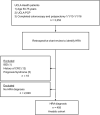Gastroenterology visitation and reminders predict surveillance uptake for patients with adenomas with high-risk features
- PMID: 33888839
- PMCID: PMC8062682
- DOI: 10.1038/s41598-021-88376-4
Gastroenterology visitation and reminders predict surveillance uptake for patients with adenomas with high-risk features
Abstract
Individuals diagnosed with colorectal adenomas with high-risk features during screening colonoscopy have increased risk for the development of subsequent adenomas and colorectal cancer. While US guidelines recommend surveillance colonoscopy at 3 years in this high-risk population, surveillance uptake is suboptimal. To inform future interventions to improve surveillance uptake, we sought to assess surveillance rates and identify facilitators of uptake in a large integrated health system. We utilized a cohort of patients with a diagnosis of ≥ 1 tubular adenoma (TA) with high-risk features (TA ≥ 1 cm, TA with villous features, TA with high-grade dysplasia, or ≥ 3 TA of any size) on colonoscopy between 2013 and 2016. Surveillance colonoscopy completion within 3.5 years of diagnosis of an adenoma with high-risk features was our primary outcome. We evaluated surveillance uptake over time and utilized logistic regression to detect factors associated with completion of surveillance colonoscopy. The final cohort was comprised of 405 patients. 172 (42.5%) patients successfully completed surveillance colonoscopy by 3.5 years. Use of a patient reminder (telephone, electronic message, or letter) for due surveillance (adjusted odds = 1.9; 95%CI = 1.2-2.8) and having ≥ 1 gastroenterology (GI) visit after diagnosis of an adenoma with high-risk features (adjusted odds = 2.6; 95%CI = 1.6-4.2) significantly predicted surveillance colonoscopy completion at 3.5 years. For patients diagnosed with adenomas with high-risk features, surveillance colonoscopy uptake is suboptimal and frequently occurs after the 3-year surveillance recommendation. Patient reminders and visitation with GI after index colonoscopy are associated with timely surveillance completion. Our findings highlight potential health system interventions to increase timely surveillance uptake for patients diagnosed with adenomas with high-risk features.
Conflict of interest statement
The authors declare no competing interests.
Figures



References
-
- Howlader, N. et al. SEER Cancer Statistics Review, 1975–2016, National Cancer Institute.
-
- Lin, J. S. et al. Screening for Colorectal Cancer: A Systematic Review for the U.S. Preventive Services Task Force. (Agency for Healthcare Research and Quality (US), 2016).

